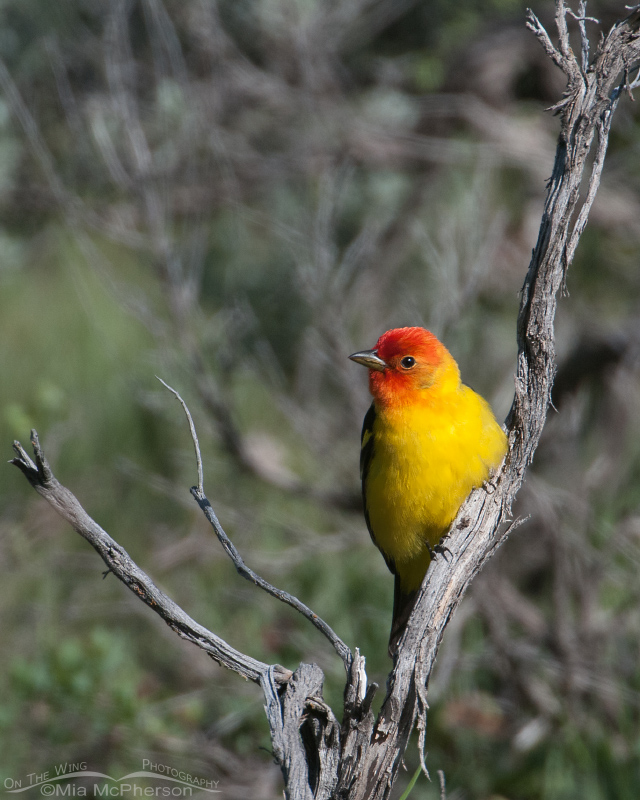 Western Tanager in the Targhee National Forest – Nikon D300, f6.3, 1/1600, ISO 500, +0.3 EV, Nikkor 200-400mm VR with 1.4x TC at 400mm, natural light
Western Tanager in the Targhee National Forest – Nikon D300, f6.3, 1/1600, ISO 500, +0.3 EV, Nikkor 200-400mm VR with 1.4x TC at 400mm, natural light
Western Tanagers could be called “flame birds” because of their bright, colorful plumage and flamed colored heads. The red pigment isn’t produced by the bird but is from their diet and they acquire that pigment from insects. The females are much duller than the male above.
The bright yellow and red of this male Western Tanager caught my eye last May while on a dirt road in the Targhee National Forest in Idaho just south of the Montana state line. I knew immediately what species the bird was when I spotted it and I am thrilled that it hung around long enough for me to get a nice series of images. I haven’t had the best opportunities with this species so I jump at every chance I get.
Western Tanagers were first recorded on the Lewis and Clark Expedition and they are primarily a western bird though during the winter vagrants have been found as far away as the eastern coast. Their diet includes berries and insects.
Western Tanagers breed further north than any other species of tanagers. Before long these bright colored birds will move into their breeding territories and maybe, just maybe, I’ll have the opportunity to photograph them again.
Life is good.
Mia
Click here to see more of my Western Tanager photos plus facts and information about this species.


What a shot! Looks like you captured a big chuunk of much appreciated sunrise! Perfect composition….love the contrast of the silvery weathered wood and the flame feathered bird!
Beautiful! Hope to see one or two this summer in Alberta. Nice to see them here on your page and read the comments.
Beautiful bird! We don’t get to see too many of these here in Florida.
Hi!
Love that colorful Bird! I don’t ever remember seeing one in my many travels? Great shooting! I am ready for Spring ,too.
Hope you get good shooting soon!
He is gorgeous!!!!!
Just gorgeous.
An ignorant question though. Is the difference in the plumage brightness because the females eat less of the insects? Or is it a reflection of the very common plumage differences…
EC, I wondered about the difference between the male & female coloration too but can’t find an exact reason for it. BNA (Birds of North America) says this on two different pages:
the male Western Tanager deposits rhodoxanthin, a rare plumage pigment, in its red feathers. The species must rely on an external source of this pigment, unlike the aforementioned species, which produce red pigments from dietary yellow pigments.
Rhodoxanthin is an uncommon pigment in birds, having been reported only in pigeons of genus Ptilonopus, several cotingas and a manakin (see Hudon 1991). Small quantities of rhodoxanthin have also been detected in Northern Cardinal (Cardinalis cardinalis; Hudon 1991) and in orange-tailed Cedar Waxwings (Bombycilla cedrorum; Hudon and Brush 1989).
I wondered myself if the differences aren’t chromosomal.
Very interesting comments and what a beautiful image. I found this statement at the nps.gov site:
The red pigment in the face of the Western Tanager is rhodoxanthin, a pigment rare in birds. It is not manufactured by the bird, as are the pigments used by the other red tanagers. Instead, it must be acquired from the diet, presumably from insects that themselves acquire the pigment from plants.
And this interesting bit: Scarlet, Flame-colored, Hepatic and Summer Tanagers all use the same ancestral mixture of pigments to produce the scarlet color.
Tanagers obtain several carotenoid pigments in their diets and deposit them in feathers to produce bright yellow and grayish-green hues. They can metabolically modify the carotenoids to produce several keto-carotenoids, which are red pigments. When the carotenoids and keto-carotenoids are mixed in the correct proportions, they produce the brilliant scarlet common to the crown feathers of all male tanagers.
Western tanagers have lost the ability to metabolically produce keto-carotenoid pigments. Instead, they use rhodoxanthin, which is synthesized in the needles of spruces, firs, pines and junipers. Herbivorous insects feeding on needles ingest and accumulate rhodoxanthin and reluctantly yield it to Western Tanagers. http://spot.colorado.edu/~mitton/PDFS/Western%20tanager.pdf
I love tanagers too Mia. Great shot – love the way you’ve framed the bird with the branches and he’s looking right at me – wonderful!
Thanks Chris!
Great shot of a beautiful bird! I rarely see this bird and it is a treat whenever I do. Seems like they never stay still long enough for a shot though (or I don’t have the right camera handy)!
Larry, they like to hide under a canopy of leaves which believe it or not makes them hard to see despite those bright colors. Thank you!
So beautiful, Mia!
Thank you Charlotte